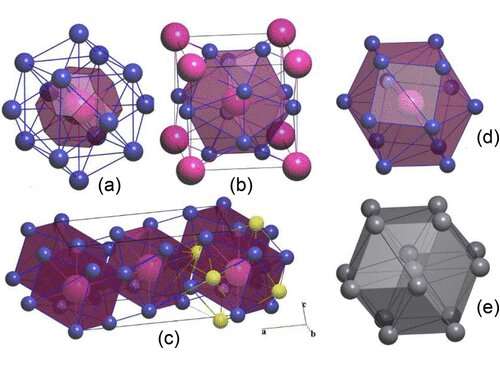This article has been reviewed according to Science X's editorial process and policies. Editors have highlighted the following attributes while ensuring the content's credibility:
fact-checked
peer-reviewed publication
trusted source
proofread
Counterintuitive lithium compounds suggest route toward high-temperature superconductivity

Researchers from Skoltech, Jiangsu Normal University, and elsewhere have predicted unexpected compounds formed by lithium and cesium under high pressure. These new substances display unexpected chemistry and never-before-seen crystal structures, and possess the much sought-after property of superconductivity, losing any electrical resistance below the critical temperatures of around minus 223 to minus 213 degrees Celsius. The study came out in Nano Letters.
Conventional chemistry says lithium and cesium don't form any compounds. But it turns out that if you put them under pressure, several compounds do emerge. Some of them had been predicted before, but a new study by a team of Chinese, Russian, and U.S. scientists used a more reliable algorithm and identified new and more stable phases.
The researchers relied on fundamental theoretical principles and the USPEX crystal structure prediction algorithm, developed earlier by study co-author and Skoltech Professor Artem R. Oganov, to discover four lithium-rich compounds with seemingly bizarre formulas such as Li14Cs, which you won't find in a chemistry textbook.
"Under normal conditions, if anything we would expect lithium to attract the electrons of cesium, which is the most electropositive element in the periodic table as most people know it: It is supposed to give up electrons, period," Oganov commented.
Electropositivity is a fundamental property of the atom of a chemical element that characterizes how eagerly it parts with electrons or, in the case of electronegativity, holds on to them. Together with his colleagues, Oganov shook up the periodic table by extending the notion of electronegativity into the realm of high pressures.
"Yet under pressure it is the other way around," the researcher went on. "Cesium grabs the electrons of lithium, and this highly unusual chemical behavior leads to the formation of the four new compounds, two of which—Li14Cs and Li6Cs—turn out to have previously unseen crystal structure topologies." This is a fairly rare thing for compounds of just two elements. "Yet here we are, with two new topologies in one binary system," Oganov added.
The team predicts that the four novel compounds of lithium and cesium should be able to conduct electricity with zero resistance. That is, below a certain critical temperature, which ranges from about minus 223 to minus 213 degrees Celsius depending on the particular compound, they are what's known as superconductors—materials sought by scientists hoping they will one day enable power grids with unprecedented efficiency, ultrafast microchips, and electromagnets strong enough to levitate trains or even control fusion reactors.
"Sure, from a technological standpoint, these critical temperatures are no good compared with what we've seen in polyhydrides—the hydrogen-rich compounds of some metals. Yet this study deepens our understanding of lithium chemistry, and lithium as such could be interesting for superconductivity, perhaps in the form of a hypothetical 'lithide' compound—so far we don't know if it exists or how to spell it," Oganov said, explaining that the lithium atom is very similar to that of hydrogen and could therefore stand in for it in a polyhydride-like compound.
Like hydrogen, lithium has one valence electron, and it is among the lightest elements, too, which is favorable for superconductivity: It is known that the lower an atom's mass, the higher the critical temperature of an associated superconductor is.
Like many other anomalies of high-pressure chemistry, the electronegativity inversion reported in this study—namely, lithium giving up electrons to cesium—was predicted by the Dong-Oganov reinvented electronegativity scale, published last year.
More information: Hong-Mei Huang et al, Novel Topological Motifs and Superconductivity in Li-Cs System, Nano Letters (2023). DOI: 10.1021/acs.nanolett.3c00875
Journal information: Nano Letters
Provided by Skolkovo Institute of Science and Technology



















